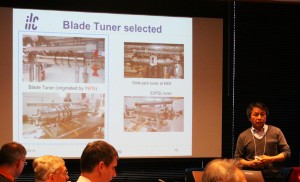Scientific oversight for the ILC Global Design Effort (GDE) is provided by the International Linear Collider Steering Committee (ILCSC), a subcommittee of the International Committee for Future Accelerators (ICFA). The ILCSC has appointed a panel of accelerator experts to review and monitor the technical progress of the GDE, as well as that of the experimental programme. This Project Advisory Committee (PAC) has met twice per year to assess our technical progress, since we began our work toward an ILC technical design. The PAC’s last review was carried out in May, before we began to write the Technical Design Report and therefore represented an especially important review of our status and readiness. I give the key findings of that review today, along with my annotated comments.
- The PAC feels that the GDE work is progressing well, and will lead to a valuable, high quality, TDR; keeping up the momentum afterwards is recognized as being significantly more difficult.
This overall conclusion provides validation that we are ready to proceed with the TDR, based on the baseline design we presented to the PAC. Keeping up the momentum following the TDR is a separate issue and I will be addressing over the coming months.
- The R&D still needed is in general aligned with the needs of the major labs, particularly DESY and Fermilab. A concern is that R&D on high-gradient cavities, particularly in the U.S., may not be supported at the ILC-needed level.
This comment is particularly important to the future R&D programme during the interim period, awaiting LHC results and prior to project approval.
- Currently, the cavity yield at goal gradient is ~ 80%, rather than the desired 90%. The PAC encourages continued R&D on this after submission of the TDR.
We set a goal of 90% yield in producing cavities, in order to be ready to cost-effectively produce cavities for the ILC. A focus of the ongoing work following the TDR will be to keep working towards being able to reliably produce high-gradient cavities. This will require systematic studies to define a cost effective process that can be used by multiple qualified vendors.
- The Committee is concerned that cavity tuners have not reached the ultra-high level of reliability required for the ILC; the PAC recommends more study and a focused program to achieve the necessary reliability.
This is the most substantive technical comment made by the PAC in this review. We are entering into a study to define the requirements for the cavity tuners, required to achieve the desired accelerator reliability. We will report the results of these studies at the next meeting of the PAC in December.
- The need to work on design for a mountainous topography site as well as a relatively flat site is being handled by the GDE as well as can be expected, and needs to continue to TDR completion.
We have adapted our baseline design to the different candidate sites, in particular mountainous sites like in Japan and flat sites like at Fermilab or near CERN. This presents complications of not presenting a single detailed design and costing, but will give more useful design information for whatever site is chosen.
- It is important to maintain the DESY cavity database, and the Committee appreciates DESY’s support of this.
The creation of a common database, originally started at DESY and later extended by the GDE for all the high-gradient cavity work around the world, has enabled quantitative comparison and compilation of results (read also Global effort for high-gradient ILC SCRF cavities and One sheet to plot them all).
- The FLASH and CesrTA studies have been of very high quality, and are essential to the design of the ILC.
The FLASH studies represent our first real systems tests with beam and the results are crucial to establishing the reality of the ILC design. This work is a precursor of future systems tests that will be carried out at Fermilab and KEK, in the post-TDR era.
- The PAC is impressed with the costing effort, which appears to be using all available information. Based upon LHC experience, the Committee advises not to use a single vendor for any large production order, even if the single-vendor price is lower than using multiple vendors
Since we only recently established the TDR baseline, the costing is still not fully available, but Gerry Dugan, the GDE cost leader, reviewed the methodology, progress to date, and plans for completing the costing. It is encouraging that the PAC was impressed with the costing. The PAC also gave sound advice on multiple versus single vendors for the costing and the project.
Overall, this PAC review substantiates our readiness to complete the TDR. That is now our main activity and our schedule is to have a very good draft TDR to submit to the PAC for review at their next meeting at KEK in December.




Recent Comments